Look what’s next on Wilshire
September 5, 2013
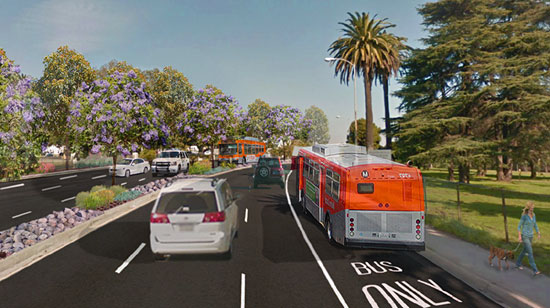
Purple-blooming jacaranda trees, shown in rendering above, will be spared when new Wilshire bus lane is built.
As the Wilshire segment of the massive 405 Project winds down, with the completion of sweeping new flyover ramps in the months ahead, another big project is about to hit the boulevard.
The Wilshire Bus Rapid Transit (BRT) project, which is creating a dedicated bus lane running from MacArthur Park to the border of Santa Monica, is set to begin work in March, 2014, on a segment of Wilshire Boulevard near the V.A. Hospital in West Los Angeles.
Construction on the Wilshire segment of the 405 Project is expected to wrap up by January, 2014. With the exception of some landscaping work, the freeway project is not anticipated to overlap with the bus lane construction.
In the V.A.-area section of the bus project, Wilshire is being widened from Bonsall Avenue to Federal/San Vicente to incorporate a new eastbound lane that buses will be able to use exclusively during peak morning and afternoon rush hour periods. In the off-hours, the new lane will be available to all vehicles.
Initially, there were concerns that more than 30 jacaranda trees that line the median on Wilshire between Federal and Bonsall would need to be removed as part of the project.
Now, however, plans call for the trees to be boxed up during construction and replanted when the widening project has been completed. Trees deemed not healthy enough to survive transplanting will be replaced.
“We’re going to improve the situation,” said Lance Grindle of the county Department of Public Works, which is designing the project and overseeing work on the .8 mile stretch. New street lighting is being installed, along with a new, more reliable irrigation system.
“There are quite a few nice healthy trees there. There are also quite a few trees that are in distress because they didn’t get enough water,” Grindle said.
In addition to replacing the jacarandas in the median, more than 35 Brisbane box trees will be planted along the north side of the boulevard with other landscaping.
“It actually creates a nice little walking area,” Grindle said.
The Los Angeles County Board of Supervisors this week authorized Public Works to move ahead with the V.A. segment of the project.
Martha Butler, director of regional transit planning for Metro, the lead agency for the project as a whole, said the new lane is essential to speeding up bus travel times along Wilshire.
“It’s the most important corridor in the county, our No. 1 in terms of ridership,” Butler said. She said the bus station at Bonsall, serving the V.A., is particularly heavily used, with 700 boardings a day.
“It really provides a critical service to veterans,” she said.
Butler noted that the new bus lane is an addition to the existing lanes on Wilshire and will not usurp any current travel space. Construction will take place in phases, beginning with the north side of Wilshire, and two lanes will remain open in each direction throughout the project. In addition to the new bus lane, there will be longer left-turn pockets on westbound Wilshire at San Vicente and on eastbound Wilshire at Sepulveda.
An initial segment of the BRT project—which in its entirety will span 12.5 miles, including 7.7 miles for buses only during peak hours—opened in June from MacArthur Park to Western Avenue. Construction on the segment running from Western to San Vicente is expected to begin this month. (The dedicated bus route is not continuous, as this map shows. Areas excluded from the project include the entire stretch of Wilshire through Beverly Hills and a one-mile stretch in Westwood.)
When the whole project is completed in November, 2014, average travel times along the corridor are expected to improve by 24% and spark a bus ridership increase of 15% to 20%.
Posted 9/5/13
A budding environmental menace
September 5, 2013
In the not-so-remote reaches of the Santa Monica Mountains, the scientists of the National Park Service are getting an unexpected and sometimes unnerving education in preserving the environment—and in protecting themselves. They’ve been forced to confront realities in the wild that could even make counting newts along a stream a risky affair.
Increasingly, park service researchers are sharing terrain with covert marijuana farmers who’ve exploited and wreaked alarming environmental damage on broad swaths of sensitive public lands as part of a multi-million-dollar trade possibly linked to Mexican cartels. With tightened security along the border, drug lords may have turned to the rugged mountains edging the L.A. basin for their cash crop.
Just last week, a pot farm was raided in Topanga State Park, one of the region’s most popular hiking destinations. Law enforcement authorities recovered 5,000 pounds of mature plants, worth an estimated $2.5 million, and removed 500 pounds of trash, camping gear and farming infrastructure. But that bust wasn’t even the largest in a series of seizures that have made headlines during the past few years, including some in the hills above Malibu.
Christy Brigham is no cop. But as chief of planning, science and resource management for the National Park Service in the Santa Monica Mountains National Recreation Area, she and her colleagues have learned to spot potential dangers and react to them, even if that means revamping long-planned research projects.
Take, for example, the red-legged frog. Brigham says the park service has been trying to reintroduce the endangered amphibian in streams across the Santa Monica Mountains. But a number of suitable sites, she says, were rejected because they had a high potential for pot farming or showed actual evidence of it, including the tell-tale black, flexible tubing that’s used to siphon stream water for irrigation of the illicit crops.
“If you had told me ten years ago that one of the things I would be doing is finding illegal marijuana gardens, I would have laughed,” Brigham says. “That’s not what I do. I’m a scientist. But you have to learn as a coping skill to identify the signs of illegal growing and respond appropriately. You try to get out of there as quickly and as quietly as possible.
“The even crazier part,” she adds, “is that not only are we identifying marijuana gardens but we’ve learned to quantify their environmental impacts so we can help the public understand how big a problem it really is.”
The damage is occurring across a number of fronts, Brigham explains, creating “a terrible ecological disruption” on lands that are supposed to be protected for public enjoyment and education.
Start with the water. Pot growers are damming low-running streams with rocks and siphoning the pooled water for distances that can stretch as far as a mile to hidden plots containing thousands of plants. Brigham says this may be endangering native stream creatures, including steel head trout, whose dwindling numbers environmental scientists have been working hard to reverse in the Santa Monica Mountains.
Then there are the nitrogen-based fertilizers that foul the creek and the rat poison that growers deploy to protect their crops from hungry critters but that moves through the food chain, jeopardizing bobcats and other large mountain mammals.
Meanwhile, the streams are further damaged by the loose soil that flows into them after growers clear wide patches of native vegetation to plant rows of seeds. Brigham says the heavy silt in the water can fill the holes of native frogs and “suffocate” fish eggs dependent on clear, oxygenated water to develop.
But the most obvious environmental toll, Brigham says, comes from the growers themselves, who live at the sites and use the land as their trash can and toilet, which scientists believe could be one factor contributing to the high bacteria levels in the ocean at the mouth of Topanga Creek.
“It’s just horrible,” Brigham says. “It’s like having a dump in the park, which is not really what we’re working toward.” She says the makeshift camps also represent a danger to hikers—and those on her staff—who like to wander off-trail along the streams. Her advice: when you see those irrigation hoses, “it’s time to leave.”
Too often, Brigham says, news of big marijuana hauls on public lands seems to lead to a discussion about whether taxpayer money is being wasted by such law enforcement efforts. But she says there’s no arguing about the cost to the environment.
“Regardless of how you feel about whether marijuana should be legalized, that debate is completely irrelevant to the environmental issue,” Brigham says. “You’ve devoted your tax dollars and your attention to these parks. They are not farms. This completely disrupts the ecology of the area. It’s terrible.”
Posted 8/22/13
A safer shortcut
September 5, 2013
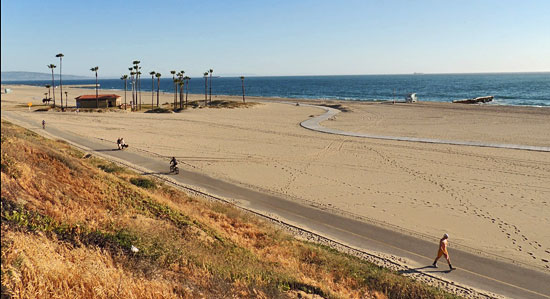
A winding bike path has some cyclists opting instead for the access road, shown in foreground above.
For years, cyclists have been streaking along a service road through Dockweiler Beach in Playa del Rey to avoid a crowded, winding, sandy stretch of the bike path just a few hundred feet away. But the popular alternate route has created safety headaches of its own when the bikes cut through an RV park to get back to the path.
“On occasion, bicyclists have been struck by motorists,” said John Burton, a civil engineer for Los Angeles County Department of Public Works. “Luckily, vehicles aren’t going too fast there.”
The county’s Department of Beaches and Harbors manages the RV lot, one of four connecting with the 1.4-mile access road. Carol Baker, a spokeswoman for the agency, said employees have long supported a separate path between the road and the beachfront Marvin Braude Bike Trail, which snakes 22 miles up the coast, through major tourist destinations like Venice and Santa Monica. Cyclists cause damage when they hit a vehicle gate arm at the lot entrance, she said, and RV tenants have voiced concerns about the large amount of two-wheeled traffic.
On Tuesday, the Board of Supervisors authorized the Department of Public Works to proceed with a grant application to fund a new 385-foot connector path so cyclists won’t have to cut through the lot. Burton, who is planning the project, said the new path will create a better environment for campers and cyclists alike.
“With this path they can enter the bike path promptly and safely,” said Burton. “Right now they have signs to discourage people from going through, but people still do because it’s the easy way to go.”
Just last winter, the county renovated part of the path to repair cracked segments. However, Eric Bruins, planning and policy director for the L.A. County Bicycle Coalition, said the real problem is the path’s layout and design.
“It’s kind of a mess right now,” he said. “There’s a lot of sand on the path sometimes, so it’s pretty dangerous at times.”
That’s prompted many riders to turn to the access road as a straight-ahead, faster moving alternate to the winding beach route, Bruins said.
Another issue arises when large numbers of pedestrians wander onto the path at popular beaches. Beachgoers “are there to have a good time,” Bruins said, “but they aren’t exactly paying attention.” He said extra signage and path striping in places like Santa Monica have helped prevent people from crossing unsafely.
Despite the bumps and bruises, the trail remains highly popular among residents and tourists.
“You don’t have that kind of uninterrupted bikeway except by the rivers inland,” Bruins said. “It is a world class amenity—one of the must-do things when you visit L.A.”
Posted 9/5/13
Working toward a safer Blue Line
August 29, 2013
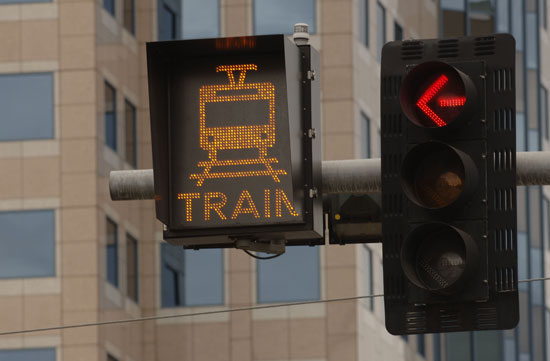
LED signs like this one in Long Beach alert pedestrians to stay off the tracks when a train is coming. Photos/Metro
One year after a task force convened to improve safety on Los Angeles Metro’s Blue Line, newly-released figures show that, while progress is being made, the line remains the deadliest in the system.
Abdul Zohbi, a system safety manager who organized the task force, says every fatality is reason for concern, but that he’s not ready to panic.
“All of our safety projects are being worked on as we speak,” Zohbi said.
Last July, officials discovered a spike in fatalities on the 22-mile light rail line from Downtown Los Angeles to Long Beach. It was on pace to experience the highest number of accidental fatalities and suicides of any year since it opened in 1990.
Acting on a motion by Supervisor Zev Yaroslavsky, Metro’s Board of Directors approved the creation of a Blue Line Task Force to find solutions for the agency’s oldest rail line.
“With our new lines, we are installing state-of-the-art devices that have come into existence in the past 20 years,” said Vijay Khawani, Metro’s executive officer of corporate safety. “A year ago we said, ‘Wait a minute, why can’t we retrofit the Blue Line?’”
Zohbi reached out to the City of Los Angeles’ Department of Transportation, the California Public Utilities Commission and Union Pacific Railroad, which runs a freight line directly alongside the Blue Line. He also invited representatives from Didi Hirsch Mental Health Services, a Culver City nonprofit organization that operates a 24-hour suicide crisis hotline.
The resulting recommendations were approved by the Board last December, and included $7.7 million for such physical improvements as pedestrian gates, bright LED signs and audible warning bell devices, although it has taken time for the measures to work their way through the bureacracy. Additional training is underway for light rail vehicle operators, including 2 days walking the line to experience the environment as pedestrians. And educational outreach to communities, another major part of the new safety program, has begun as well. “We expect the public to do their part in heeding the signs,” Zohbi said.
The outreach and training have already begun, and most of the physical improvements like the new LED signage are expected to be finished by around June of next year. But the improvements Zohbi believes will be most effective—108 new pedestrian gates—must be contracted out competitively, which will take longer.
In the meantime, safety issues continue to plague the Blue Line. According to statistics released Monday, it experienced more accidents and fatalities than all other Metro lines combined since the beginning of 2012, accounting for 56 of 77 accidents involving trains and pedestrians or cars during the period, along with 12 of 14 total fatalities.
“We need a physical barrier to stop people trying to cross the tracks illegally,” Zohbi said. “The No. 1 cause of accidental fatalities on the Blue Line is pedestrians running to catch a train. When you’re trying to save 30 seconds, you could lose your life.”
Tragically, even more deaths are intentional—half of the fatalities in 2012 and 75 percent of deaths so far this year were suicides. The task force called for suicide prevention signs with Didi Hirsch’s 24-hour hotline number to be installed at stations and other key locations. Those signs are 90 percent installed along the Blue Line. When that job is finished, they’ll be installed on the rest of the rail system.
Lyn Morris, who represented Didi Hirsch on the task force, said the signs represent “a big step ahead” by Metro.
“It wasn’t always popular to put the word ‘suicide’ on signs,” Morris said. “People like to talk around it, but when you are talking to someone who is suicidal you need to address it directly.”
The signs have only been in place for a couple of months, but Morris said her agency has already fielded calls generated by them, including some from people in a state of crisis. But beside that point-of-contact intervention, she said the signs serve a much broader purpose—spreading the word to communities across the county that someone is out there to listen and help at the most seemingly-hopeless times.
Both Morris and Bruce Shelburne, Metro’s rail operations chief, admitted that it’s next to impossible to eliminate all accidents resulting from people who break the law or attempt suicide.
“We are eating an elephant one bite at a time,” Shelburne said. “It’s a fine line—the safest train is one that doesn’t run at all.”
The Blue Line faces unique challenges. For one, it is Metro’s oldest rail line; the Teenage Mutant Ninja Turtles were used to promote its June, 1990, opening. And it runs through a densely populated part of town, with 103 at-grade crossings with other streets. Over the first 12 years of the line’s operation, it experienced more fatalities than any other line in the nation. In 1999, after a particularly rough year, Metro added safety measures that cut deaths by nearly half during the next decade.
While behavior of pedestrians and vehicular traffic can’t be predicted to a certainty, Zohbi called all fatalities “unnecessary.”
“To bring the fatalities down to zero,” he said, “that is our optimal goal.”
Posted 8/29/13
Where summer lingers after Labor Day
August 29, 2013
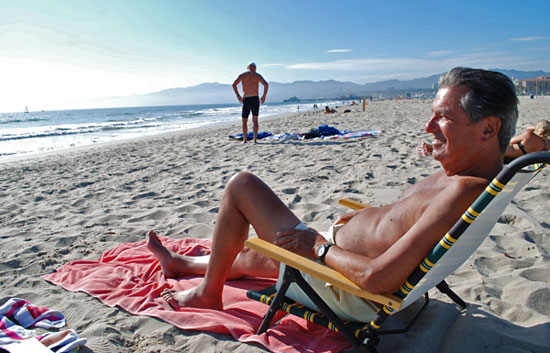
Lance Wichmann says he finds serenity on the Santa Monica sand when the crowds disappear in September.
Lance Wichmann’s playpen was a patch of warm sand at the foot of Ocean Park Boulevard. His family’s Santa Monica house was less than a block from the beach, and his mom started carrying him there before he could walk.
Today, more than seven decades later, you can still find Wichmann at that same spot, sunning himself in retirement, a few tentative steps from the shoreline home that remains in the family. He knows just about everything there is to know about beach life around lifeguard station 26, which draws some of the heaviest crowds in Southern California during June, July and August.
And one of the things Wichmann knows (besides the best body-surfing breaks) is this: although Labor Day on Monday represents the unofficial end of summer, it’s the beginning of a two-month-long, locals-only holiday, when ideal conditions come to the beach—but not the people. The truth is that, unlike other coastal areas throughout the nation, air and sea temperatures here drop an average of only a few degrees between Labor Day and Halloween.
“It’s so much quieter,” the 72-year-old former insurance executive said of LA.’s extended summer season of September and October. “I know Santa Monica is a tourist town, but I like it when I can come down here at low tide, when the kids are back in school, and walk along the sand by myself. To me, it’s spiritual.”
Let the rest of the country use Labor Day as its farewell to summer. Here in L.A., savvy beachgoers know that the occasion actually signals “the start of the beach season,” joked county lifeguard Captain Kyle Daniels, who oversees community services and youth programs. In September and October, he says, “the days are warmer, the winds are lighter and the views of Catalina are better.”
And the crowds are so much thinner that, after Labor Day, lifeguard stations are staffed every mile or more, rather than every 200 yards. “I don’t want to say it’s easy,” Daniels said of the workload that comes with reduced staffing levels. “But it’s less intense.”
There are other signs in the bureaucracy that, come this weekend, vacationers are about to vanish.
Carol Baker, a spokesperson for the Department of Beaches and Harbors, offered this post-Labor Day tidbit: the agency’s facilities and property maintenance division, which oversees beach restrooms, has just received its last major order of toilet paper and expects to use only 400 cases during the winter months, compared to as many as 1,000 cases during the summer.
When asked about her own favorite beach month, Baker declined to pick a favorite. “I know this will sound like a bubbly cheerleader, but every month at the beach is my favorite.” That said, she acknowledged that “some of the best summer days are in the fall.”
And that may be particularly true this year because of the fog that has shrouded the coastline during August—or, as Baker calls it, “Fogust.” This week saw some of the best weather of the summer, with the weekday visitor count already way down.
“In July, you could barely see the sand, there were so many people,” lifeguard Chris Smith said on a brilliant Tuesday afternoon as he kept watch over a couple of body boarders and surfers not far from where Wichmann was working on his tan. “The crowd is non-existent right now.”
“It’s a secret,” he added, “that the beach season is still going strong in October.”
Up along the bike path, meanwhile, business was slow enough at Perry’s café that chef Robin Hathaway could take a break to talk to a visitor about the post-Labor Day rhythms. “All the locals come down to reclaim their spots,” Hathaway said. “People have their routines. It’s more health and fitness oriented—running, riding, yoga, skate boarding, surfing.”
Of course, if the café had its way, she said with a wink, “summer would last forever.”
Posted 8/29/13
Historic fire’s legacy lives on
August 28, 2013
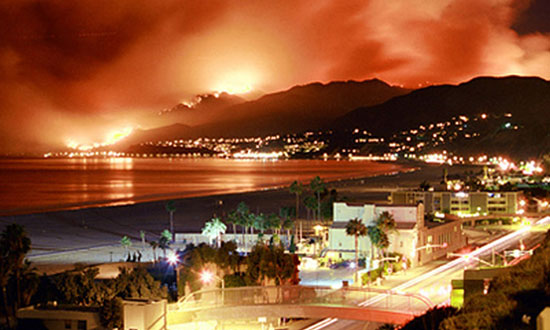
The Old Topanga Fire drove home the need for Super Scoopers. Topanga Messenger photo/Martin Nate Rawner
The first spark was sighted at 10:46 a.m. on the first Tuesday of November, 1993. It was hot. The Santa Anas were gusting. Fires had just consumed swaths of Altadena and Laguna Beach, and now came a 911 call to report a fire on Old Topanga Canyon Road, near the water tower. Minutes later, the smoke could be seen from a half-mile away.
Over the course of 10 days, the Old Topanga Fire would consume 16,516 acres, killing three people and injuring 21 others. Some residents will never forget the way it exploded through Malibu, hopping from canyon to canyon, cresting Saddle Peak in a 200-foot-long wall of flame.
But the fire also made another kind of history in Los Angeles County. In the wake of its devastation, the county became the first jurisdiction in California to begin regularly leasing the Canadian tanker planes known as “Super Scoopers”—a move for which firefighters were particularly grateful this week as a far-earlier-than-usual fire season hit Yosemite National Park, scorching a wilderness area the size of Chicago.
“The fires this year have been extreme,” says Los Angeles County Fire Chief Daryl Osby, citing the hundreds of fires that occurred this year throughout California. The Springs Fire struck in May, and then came June’s Powerhouse Fire, which destroyed more than 32,000 acres and some two dozen houses near Lake Hughes in a month that, in past years, has always been cool and foggy.
Lower-than-usual rainfall and a lack of June gloom, he says, have made the canyons as dry now as they usually are in autumn, when the Santa Ana winds typically turn L.A.’s canyons into fire hazards. Worse, the county hasn’t had a major fire since 2009, meaning that the county has mountains of parched vegetation to burn.
All of this, meanwhile, comes in the midst of a three-year drought that has disrupted conventional fire patterns. How much it all has to do with climate change is beyond his expertise, the chief says, but the upshot has been a new kind of fire season—bigger, earlier, less predictable and more lethal than ever.
“The Powerhouse Fire burned like it was September, and it wasn’t even being pushed by Santa Anas,” he says. “I can’t say yet whether this season is going to be the worst ever, but the potential is there.”
That, he says, is why the county moved up this year’s timeline by a full month for arrival of the Bombardier CL-415 Super Scoopers that it has leased for the past 19 years from the government of Quebec. Able to fly at speeds of up to 170 mph, the iconic yellow planes dip into oceans and lakes, pulling in 1,620 gallons of water in 12 seconds to dump from the air onto brushfires—a powerful tool for which canyon dwellers lobbied mightily after the 1993 fire.
“We’ve known since probably around February that we had the potential for a volatile fire season,” says Osby. “When we saw in June that the fuel moisture levels in our vegetation were already down to what we would normally see in September, we started collaborating with Quebec to see how early we could get the Super Scoopers.”
The planes arrived with their Canadian crews on August 15, as opposed to their usual start date in mid-September, and already they have been deployed on brushfires in Topanga and Calabasas.
“Your fire conditions in L.A. are worse than in the past years,” says Chief Pilot Carl Villeneuve, who expects to remain with the two leased planes until mid-December, if not longer. “Those two fires weren’t hard to put out because there are no big winds yet, but when the big winds come, that could change.”
Osby says the early Super Scooper deployment is just one part of a strategy to pre-empt a potentially lethal autumn. (The two planes were joined by an Erickson Air-Crane Helitanker, also contracted this year for extra backup.)
“We have also been aggressive with our fire prevention inspections, and in working with citizens to ensure proper brush clearance,” the fire chief says. “We provided additional training to our firefighters, getting them out to wild lands for practice. We did additional simulations with surrounding agencies, and intensified training with our incident management teams.”
The department has been urging the public to be vigilant, to become familiar with the department’s “Ready! Set! Go!” program and to evacuate when fire officials tell them to get out of a threatened area, rather than stick around to try to guard their houses.
“Our response capability is better now than it was 20 years ago,” Osby says. “We have additional aircraft, more sophisticated training and better weather predictions.”
Posted 8/28/13
A magic moment, even for Bowl pros
August 28, 2013

Sarah Horn, left, with Kristin Chenoweth after they shared their "a star is born" moment at the Bowl.
The people who work behind the scenes to produce one memorable concert after another at the Hollywood Bowl every summer might be forgiven for getting a little jaded.
This season alone, they’ve witnessed superstars ranging from Willie Nelson and Diana Ross to Yo-Yo Ma and Itzhak Perlman performing under the stars before tens of thousands of people.
So that makes what happened at the Bowl last Friday all the more remarkable.
A music teacher from Riverside named Sarah Horn, selected from the audience to sing a duet with Kristin Chenoweth, turned in a note-perfect performance of “For Good” from “Wicked” that did more than bring the Bowl audience to its feet. It also knocked the seasoned Bowl staff off theirs.
“All you could hear [backstage] was ‘Wow!’ Other than that, you could have heard a pin drop,” said Paul Geller, production director for the Bowl and the Los Angeles Philharmonic, which leases and operates the county-owned facility.
The Bowl team, along with the concert audience of 9,214, was the first to witness Horn’s performance, in which she harmonized fluidly and effortlessly traded solos with Broadway legend Chenoweth. But they weren’t the last. A friend’s video of their performance, posted to YouTube, had racked up more than 2.2 million hits as of Tuesday afternoon. Her own account of the evening was posted on Broadway World.com and the story has been picked up by media outlets ranging from the Huffington Post to the Hollywood Reporter.
“I was there and it was amazing,” said Chris Ayzoukian, the Philharmonic vice president who oversees the orchestra as well as productions at the Bowl and Disney Hall. “We see a lot of shows. Magic happens a lot at the Hollywood Bowl…but when something special happens, you just feel it in the air.”
As the second half of the concert got underway, Ayzoukian was attending to his usual performance night duties from Box 1041, texting staffers backstage with comments about audio and video quality.
Then Chenoweth selected Horn—who was attending the concert with friends and family—from among fans in the audience vying for a chance to sing onstage with her.
“Sarah sang literally the first note and we were like, ‘Hello. This is serious business,’ ” Ayzoukian recalled.
In short order, he stopped texting the backstage crew about technical issues and started sending messages like: “Wow, someone hire her immediately.”
Horn, of course, was living out a popular fantasy: who hasn’t daydreamed of belting out a show-stopping number before a spellbound audience? Then there was the undeniable tension inherent in the moment: would this unknown blow her big chance, forget the lyrics, sing out of tune?
No, no and no.
“I think part of it is the sense of surprise—this amazing singer who’s among us in the audience. She represented everyone in the audience that day,” Ayzoukian said. “That’s why it was so inspiring.”
(Inspiring, and so good that the questions started almost immediately: was Horn a plant? “Absolutely not,” the Philharmonic says.)
After the show, Geller, the production director, raced into the audience to get the voice teacher’s contact information and invite her backstage.
“Both she and her parents were fairly wide-eyed,” Geller said. “They knew that they were walking backstage at a world-famous venue.”
The crowd of VIPs clustered around Chenoweth’s dressing room—“all pretty high-powered people in the industry,” as Geller put it—gave her a welcome to remember.
“As soon as they saw her, they started chanting, ‘Sarah! Sarah!’ ” Geller said. “It was the most unbelievable experience.”
Geller, who has worked at the Bowl since 1970, has had his share of incredible moments over the years and this one, he said, is going on the list. “It was moving,” he said, “for all of us there.”
Meanwhile, Horn’s return engagement at the Bowl already has been booked. She’ll be serving as a guest judge of ABBA-Capella, a “show-tune-styled sing-off” contest among collegiate groups that is part of the Bowl’s ABBA Fest concert on Sunday, Sept. 8.
Posted 8/28/13
The 405′s teachable moment
August 22, 2013
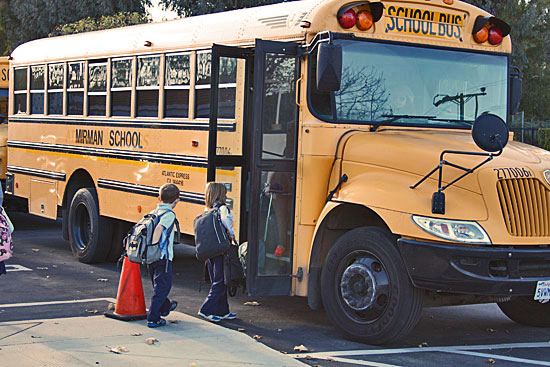
Nearly one-third of Mirman School students now ride the bus, along with pupils from nearby Berkeley Hall.
It’s that time of year again, when parents and kids run around making sure they’ve got all those back-to-school essentials: backpack, glue sticks, highlighter pens, detour map…
In the 405 Project zone, the start of the school year comes with an extra dose of uncertainty as extended ramp closures, lane reductions and other traffic headaches can make tardy slips seem as inevitable as pop quizzes.
This year, as the long-running project heads into the homestretch, two major, months-long ramp closures are adding to the already challenging traffic patterns that accompany the first weeks of school.
At 10 p.m. tonight (Thursday, August 22), the eastbound Wilshire on-ramp to the northbound 405 Freeway will be closing for 90 days. The work is needed to complete the ambitious flyover ramps portion of the project, which is expected to make it safer and easier to enter and exit the freeway at Wilshire Boulevard. When finished, the new, longer on-ramp will be able to accommodate nearly three times as many vehicles.
At the same time, the Sunset Boulevard off-ramp of the northbound 405 is also closed until November in order to create a longer, wider ramp that can hold 60% more vehicles. (Detour information for both closures is here.)
Meanwhile, the Mulholland Bridge over the 405, under construction after being dismantled in two Carmageddons, is still down to one open lane in each direction, slowing the commute to and from numerous private schools located on Mulholland Drive.
It all adds up to a rolling real-life lesson in planning, coping and improvising. And, as strange as it may seem, some of the solutions to emerge are now so popular that they’re likely to outlast the project.
Like the shared busing program developed to transport Mirman School and Berkeley Hall students through the Mulholland maelstrom that the construction unleashed.
“We never had a bus. It never seemed like it was warranted,” said Jocelyn Balaban, the Mirman administrator who developed the program. “The 405 construction pushed it.”
Now, more than 100 children, nearly one-third of the student body, are riding the school’s small fleet of buses, she said.
“The kids love the bus,” she said, and so do parents happy to dispense with the stress of fighting traffic every morning. “One father said to me, ‘I’m a better parent because of this.’ ”
Robert Woolley, a former Mirman administrator who served as the institutional coordinator for the Mulholland Educational Corridor Association when the 405 Project first rolled out, said the construction required radical readjustments to family routines.
“When Carmageddon first happened, gosh, the first couple of weeks it took people an hour or an hour and a half to get to school because of reduced capacity on the bridge,” said Woolley, now the director of development for USC’s Dornsife College. “A lot of parents waited till the last minute to drop off their kids. People learned, but there were a couple of weeks when it was really rough.”
It didn’t help that Carmageddon—the weekend-long freeway closure to pull down half of the Mulholland Bridge—had finished early and without the dire traffic impact many had predicted. Some parents, he said, “got lulled into a false sense of security and then the first day of school hit—BAM!”
After that, carpooling and busing really took off.
Those tactics also have proven popular at the Brentwood School off Sunset Boulevard, where they’re approaching the first day of school Tuesday with cautious optimism about traffic—despite the ramp closures.
“I think we’ve navigated the major closures to date pretty well,” said Shirley Blake, the schools’ director of communications.
The school’s other coping strategies include scheduling parent meetings and school events at non-peak traffic times and having faculty and staff arrive for work before 7:30 a.m. Students who drive themselves to school are required to travel in carpools and also arrive before 7:30 a.m. That policy predates the project but “it has certainly helped and I think it’s increased,” Blake said.
“We are just rolling with the punches,” she added.
Cori Solomon, president of the Brentwood Glen Association, is also used to rolling with the punches but she’s nervous about what the beginning of this school year will bring to her neighborhood. “Even though it’s old hat, I definitely have apprehension” about the simultaneous ramp closures, Solomon said. The Sunset ramp closure, which started August 3, “hasn’t been too bad—but school has been out.”
UCLA, which is “really the 800-pound gorilla,” starts Sept. 23.
By this time next year, the project—with its ramp and bridge improvements and new, 10-mile northbound carpool lane—is expected to be finished. With three back-to-school seasons under their belts, project officials are approaching the fourth with an array of mitigation measures.
A new, three-lane northbound on-ramp to the freeway from Santa Monica Boulevard reopened this week, just in time to serve as an alternative for motorists stymied by the Wilshire on-ramp closure.
Officials also are doubling the number of traffic control officers—from 12 to 24—at intersections in the area.
“Those will remain in place all next week as schools go back,” said Kasey Shuda, construction relations manager for the project. She said that officers will continue to be stationed at “prime locations” even after the back-to-school rush subsides.
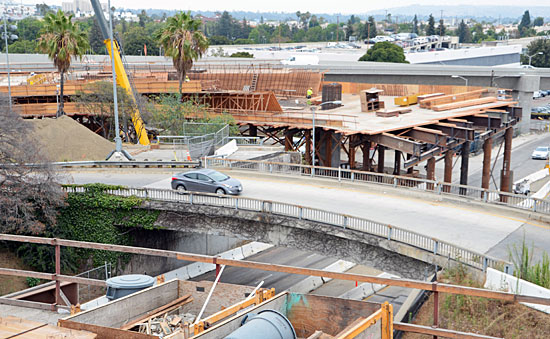
The current northbound on-ramp from eastbound Wilshire, shown at center, will be demolished. Photo/Metro
Posted 8/22/13
Feeling the burn at the Bowl
August 21, 2013
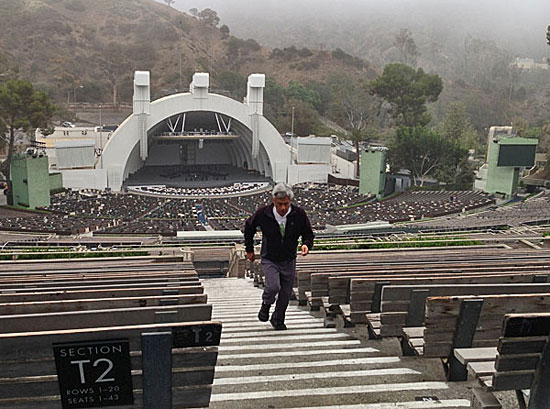
Robert Almodovar loves the Hollywood Bowl both for its music and for the workout he gets on the stairs.
By night, the steps of the Hollywood Bowl fill with music lovers, filing into their seats with picnics, popcorn and wine. Come sunup, however, a whole other crowd hits the house—locals like Robert Almodovar, for whom the Bowl is not just a world-renowned concert shell but also Los Angeles’ most iconic Stairmaster.
“It’s a beautiful place and I live just up the street,” panted the 61-year-old actor, smiling as he jogged uphill between the Garden Level boxes and the cheap seats on Tuesday morning. “I know all the guys who work here. I’ve been coming for years.”
Almodovar is among thousands of Angelenos who use the Bowl for recreation and fitness—a side attraction that stems from the fact that, when the Bowl isn’t serving as one of L.A.’s best-loved cultural destinations, it’s a Los Angeles County regional park.
“We get close to a million visitors coming by the park in the off-season and when we’re not having concerts,” said Gail Samuels, chief operating officer for the Los Angeles Philharmonic, which operates the Bowl under a lease with the county. Some of them picnic, she said. Some meditate. Some wander in during the summer for kids’ programs, or to quietly eavesdrop on open rehearsals. But for neighbors, the Bowl’s cardio benefits are an undeniable attraction.
“People walk the stairs, people walk the hillside,” said Samuels. “It’s a pretty steep grade, and definitely a good workout.”
“Every day, you see runners here,” agreed Bowl operations director Christine Whitman, strolling the foggy amphitheater as Almodovar worked out in the distance. Onstage, crews behind her toted chairs and music stands for Itzhak Perlman’s rehearsal later in the morning with the L.A. Phil.
“People come first thing in the morning when the gates open, and after work in the evening. When school is in session, the kids come up from Hollywood High School.”
Personal trainers meet clients at the Bowl. Local bloggers discover and rediscover the stairs there. This weekend, a fitness event there for Los Angeles County employees is expected to draw several hundred office workers for a power walk and choreographed dance workout.
As the nation’s largest natural amphitheater, Whitman said, it’s a natural athletic challenge: “From the Pool Circle to the back of the house, it’s 450 linear feet with a hundred-foot rise, so you can imagine how that would make your heart race.”
The Bowl and its grounds are free and open to the public from sunrise to sunset daily, except during closed rehearsals and after about 3 p.m. on concert nights. Parking is also free during the Bowl’s off-hours. Because the musicians prefer not to be distracted, the stairs are closed to runners during summer rehearsals, which typically run from 9:30 a.m. to 12:30 p.m.
“But otherwise, people can be there all day,” Whitman said.
It’s a fact that not all Angelenos are aware of. While exercisers jam public stairways in Santa Monica, Silver Lake, Rustic Canyon and other hilly parts of the city, only the bolder—and better informed—fitness buffs tend to brave the climb at the Bowl.
“We weren’t sure if it was OK to be here, but we thought we’d just keep walking until we got yelled at,” John Justice Parker, a 26-year-old songwriter, actor and newcomer to Los Angeles, confessed Monday evening as he and three friends made the long trek from the bottom to the top of Aisle 3, their calves burning.
“But we’re a pretty single-minded group and we wanted to conquer the mountain.”
“Also we wanted to get a picture from the top,” added Brandon Blouin, his out-of-town friend.
Almodovar applauds their effort. He has honed his own workout to maximize the Bowl’s assets.
“I do a stretching routine to work on all the aches and pains,” he said. “Then I do sit-ups. Then I start a very sloooow, old-man jog through the Bowl, all the way to the picnic area at the top. Then I come down and do the stairs.”
All in all, he says, it takes him about an hour and 20 minutes. But his work demands that he stay in shape. Along with TV and film roles, he does theater and is a familiar face in commercials for tires, credit cards and restaurants.
“I’ve been here every day for the last two weeks, except for one day when I had an audition,” said Almodovar, giving himself a personal high-five as he finished his run and the morning fog gave way to sunshine.
“Wooh! This is what we love about exercise, isn’t it? I’m awake!”
And all before the first note of the day sounded on the legendary Bowl stage.
Posted 8/21/13




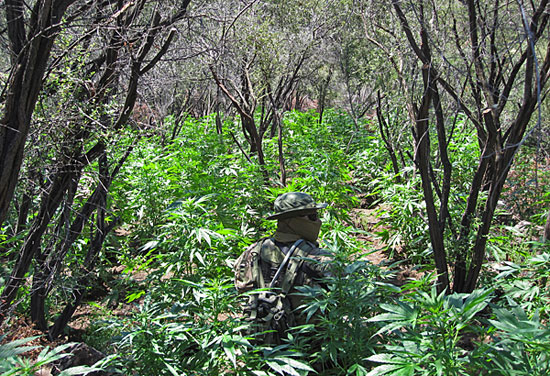
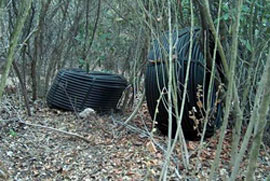
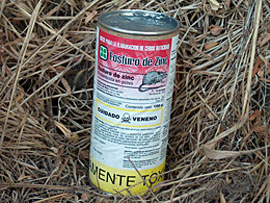
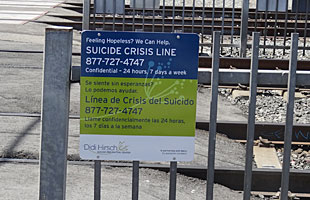
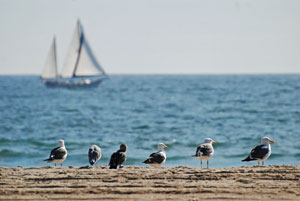
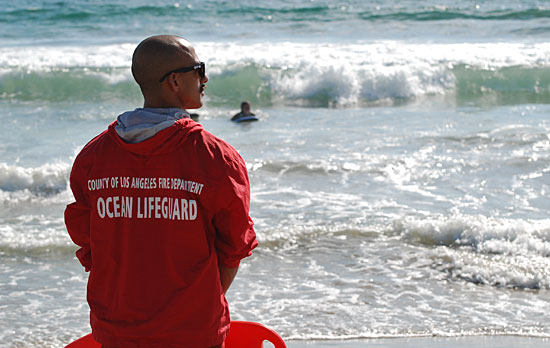
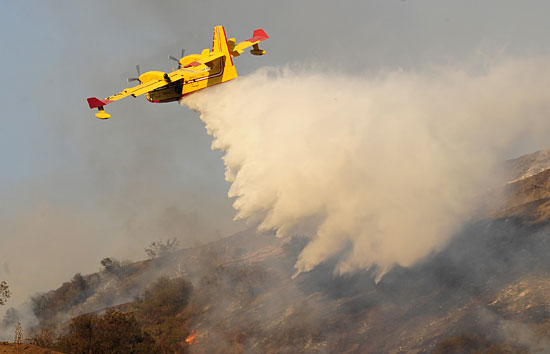

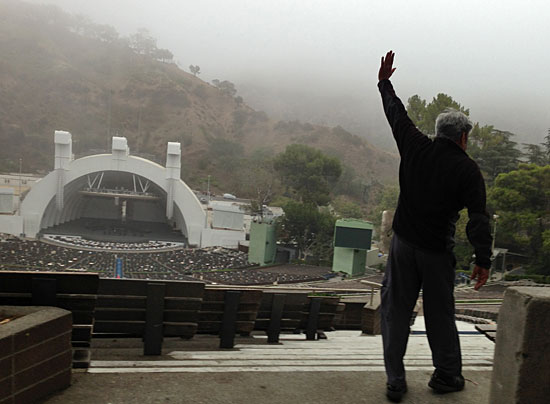





 Check for the latest closure information
Check for the latest closure information








